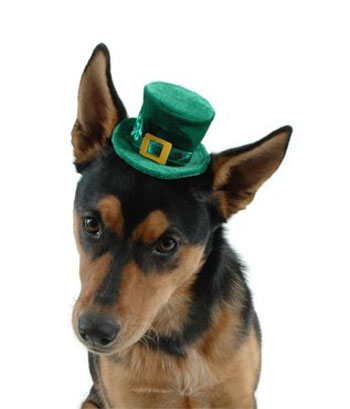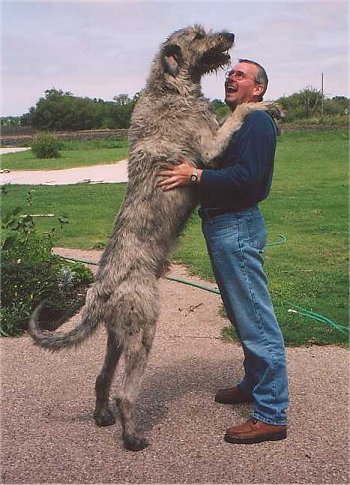Slaughter Hounds in Celtic Ireland May 21, 2014
Author: Beach Combing | in : Ancient, Medieval , trackbackA recent story on the supposed archaeological discovery of shuck – [sorry can’t give links, wordpress playing up] – has set me thinking about large violent dogs in history, the way that ancient and medieval peoples used these animals and one particularly evil-sounding example: the Irish archu or slaughter hound. First, though, some background. Dogs, of course, are the oldest domesticated animals. Dogs, indeed, were one of only two ‘humanised’ animals in the Americas prior to Columbus, having crossed the Siberian landbridge into the New World. Their remains – sometimes eaten, sometimes dumped, sometimes buried with great care – are found in practically every early society.
Ireland is special though in terms of that evidence. There is a good archaeological culture in the island, which has turned up, over the last two hundred years, some remarkable objects for antiquity and the middle ages. There is also an important canon of Dark Age writing in both Latin and Old/Middle Irish detailing aspects of life that are not always found elsewhere in Europe. For example, there are two early medieval lawcodes that are given over particularly to the question of dogs; there is also a surviving Irish lawcode on beekeeping so don’t be surprised. One of these dog codes notes that there were four dog types in Ireland: the shepherd dog, the lap dog, the hunting dog and our friend the slaughter dog. The very fact that hunting dogs were not viewed as slaughter dogs, tells you that we are dealing with a different category of terror here.
What did the slaughter dog do? Its first role seems to have been as a guard dog: it was often referred to, in fact, as ‘the dog of the four doors’. However, make no mistake it also took offensive action. Slaughter dogs were taken into battle and perhaps most chillingly the aire echta, the Lord of blood vengeance, had an archu by right. For those not familiar with the nastiness of tribal life, the aire echta was responsible for internal discipline in the extended clans and also revenged any outside incursions. If you want to imagine the archu in its element then picture this. The LoBV and his five archu are chasing some peasants from a neighbouring valley up a mountain slope: something to do with stolen poultry. When the LoBV gets within a hundred yards the dogs are loosed (two early Irish legends describe slaughter hounds being taken off the leash to attack): they were expected simply to kill and the peasants would have had to turn and fight to stand the slightest chance.
The slaughter hounds appears not only in legal codes but also in legend. In one of the Fennian sagas a dog is loosed and dispatched by an enemy who lifts its front leg and bashes its head against a rock. (Good luck with that!!) In one late medieval life of St Patrick, meanwhile, an attack dog is stopped by the sign of the cross. Fascinatingly, Irish slaughter dogs may also have been traded abroad. There is a difficult passage in the Confessio of St Patrick that might refer to Irish dogs: the Confessio is probably fifth century. There is far more intriguingly a reference to septem Scottici canes, seven Scottic Dogs (Scottus in Latin refers to Irish or later Scots, i.e. Gaelic speakers) being traded to Rome in the fourth century and appearing in the games there. All Rome watched with wonder: apart presumably the poor gladiators expected to dispatch them.
What kind of dog was the slaughter hound? The temptation to make it into an Irish wolfhound is strong. Other thoughts: drbeachcombing At yahoo DOT com
21 May 2014 Three early answers worth rushing up. First, LTM. ‘Most likely the “slaughter dog” was a wolfhound. BUT the modern wolfhound may only approximate the historical record. The breed was revived in the late 19th century by Capt. Augustus Graham. He used a mixture of what he alleged were the last authentic IWs, Scottish deerhounds and Great Danes. The authority of wolfhounds was the late Alfred DeQuoy. He was totally involved with the hounds as a breeder, judge, historian, lecturer, etc. He authored a dozen books and countless articles on wolfhounds, including “The Irish Wolfhound in Literature and Law, “ “The Irish Wolfhound Guide,” and “The Irish Wolfhound Saga.” The last book was only published in the first of three planned volumes as DeQuoy died before finishing. You might find his “Modern Wolf and Irish Wolfhound Skeletons” a bit overwhelming; he compares wolves and dog skeletons found in Ireland going back centuries. DeQuoy was well-known in the IW community, especially for his request in the Guide asking people send him the heads of their deceased dogs for study. He told me that he only received two heads. Perhaps that was because he asked that they be boiled first and scraped by a professional before sending. DeQuoy collected (and listed) the names of 268 wolfhounds named in ancient Irish literature. I’ve had IWs since 1970 and done some research myself. That’s another story. One bit of trivia: The late Dr Alex Comfort, who made many millions by writing many books such as “The Joy of Sex,” was by profession a gerontologist who received a doctorate on writing “Longevity and Mortality in Irish Wolfhounds (1956).” It remains the best study on longevity in dogs. There are basically two words for dogs in modern Irish. “Madre” is the most common, followed by ”cu.” “Cu” is reserved for hounds, specifically wolfhounds, but P. W. Joyce says it means any fierce dog. Next is KMH making the mythic connection. ‘The dog does occupy a special place among domesticated animals. Perhaps there is some unrealized relation between the slaughter hounds and the demon dogs with glowing red eyes that could arouse a great deal of fear in those crossing their path at night. They were always black in color and quite large and menacing. I will leave the research to those interested in the topic.’ Jake, meanwhile, writes: first, the sagas may not be useful for contemporary activities though I admit the lawcodes are. second, there is a fascinating parallel here between chariots and war dogs. Both chariots and war dogs were used by the ancient Gauls, at the other end of the Celtic continuum, both archaic usages died out in Gaul surviving only in Ireland among the Celts. What did Binchy say about a conservative society? Thanks LTM, KMH and Jake!
28 May 2014: Mauro C writes in Hello Doctor. I’ve done a bit of research on the subject and, I strongly suspect, we are dealing with full blown war hounds here.Hounds started to be used in warfare around the 7th century in Asia Minor and Greece. The first recorded use was by the Lydians in their war against the Cimmerians and by Ephesus against the Magnesians. In both cases a wave of hounds was let loose before the attack to disrupt the defenders before a cavalry charge.The Romans were very, very fond of war hounds and not only used them extensively but left us some interesting snippets of information that may help us track down the origins of the Irish slaughter hound.I am quoting from memory here, so I may be wrong, but Aelian wrote the Kings of Epirus had a breed of war hounds, called Molossi (from the region of Molossia) which were in extremely high demand for being both fierce fighters and easy to train. These hounds had been bred specifically for warfare and were traded all over Europe. The Romans bought as many of them as they could (until they took over Epirus for themselves) and regarded them as the best war hounds by a fair margin.The Romans had a nasty surprise when the Arverni (a Gaulish tribe) made extensive use of well trained war hounds, hinting at the fact the trade Aelian mentioned had reached the Celtic World.These hounds were most likely the ancestors of the modern day Mastiffs, disproving the old idea these breeds were first brought to Europe by Alexander’s men and successors from Central Asia. Dogs were important trade goods in the Ancient World: one only needs to look at the greyhounds. First bred in North Africa as sighthounds (meaning dogs that hunt primarily by sight), they were spread all over the Mediterranean and beyond by Phoenician and Carthaginesian traders. The new owners bred them with local dogs to adapt them to the local environment and their personal tastes, giving rise to such diverse breeds as Afghan Hound and the Irish Wolhound.The Irish most likely obtained war hounds through trade (from where exactly is an interesting although irrelevant question) and then used in the neverending bloody wars chronicled in their sagas. Now, according to Aelian, these hounds were expensive and training them took time and effort. Owning them in a relatively poor society as Celtic Ireland was sure to be a badge of rank, meaning only the aire echta and the wealthiest and most powerful individuals could afford them.Also the appearance os such exotic beasts on the field was sure to leave an indelible mark upon witnesses: Cu Chulainn probably got his popular nickname (‘The Hound of Ulster’) because of his striking appearance and fierce demeanor in battle. Very much like a war hound this legendary hero was a rare and terrible sight to behold. To reinforce his reputation as fearsome warrior, he killed a war hound as a mere boy with nothing more than his bare hands and a stone. Listeners of sagas, who may have beholden a war hound in battle, were left to make the connection: how strong would this boy grow in manhood, if he slew such a fearsome beast all by himself and without weapons? The same saga provides insight about the value of a war hound: the blacksmith Culann is absolutely devastated by the loss of his war hound, so much that Cu Chulainn, despite having acted in self defense, promises to procure and raise him a replacement. Until then, he will act as a Culann’s “war hound”, hence his name (which means Culann’s hound). Thanks Mauro C!




